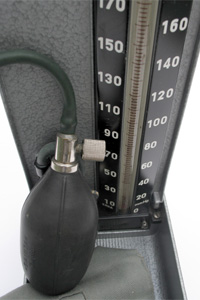Electroacupuncture for High Blood Pressure
Kristen Sparrow • August 17, 2024


This article looks at an array of devices being studied to lower blood pressure. They cite an electroacupuncture device that can be used at home that is under study. We’ll see about that, but acupuncture and electroacupuncture do seem to help@
We’ve discussed acupuncture and high blood pressure here and here.
Tolu-Akinnawo O, Ray DN, Awosanya T, Nzerue C, Okafor H. Hypertension and Device-Based Therapies for Resistant Hypertension: An Up-to-Date Review. Cureus. 2024 Aug 6;16(8):e66304. doi: 10.7759/cureus.66304. PMID: 39108770; PMCID: PMC11302934.
Electro-Acupuncture
Electro-acupuncture, although initially developed for treating peripheral pain syndrome, has unexpectedly demonstrated efficacy in reducing BP. This technique involves the stimulation of the median nerve, which is thought to modulate the sympathetic nervous system, thereby influencing cardiovascular function and leading to lowered BP levels.
Clinical trials and evidence: Electro-acupuncture has been the subject of various clinical trials to evaluate its effectiveness in BP management. One notable study involved using the eCoin device, a minimally invasive electro-acupuncture device that delivers low-frequency electrical stimulation. This device is designed to provide 30 minutes of stimulation weekly, targeting the median nerve bilaterally.
Key findings: Significant reductions in BP were observed in a recent multi-center, prospective, double-blinded, sham-controlled, and randomized (1:1) trial utilizing the eCoin device. The study reported a mean BP reduction of over 10 mmHg after six months of treatment [56]. This result highlights the potential of electro-acupuncture as a viable non-pharmacological intervention for hypertension management [56].
Regulatory and approval status: Despite funding challenges during its development and trial phases, the eCoin device demonstrated sufficient efficacy and safety to gain regulatory approval. In March 2022, the device received approval from the US FDA for treating urinary urge incontinence, further validating its therapeutic potential [57]. It has yet to however receive FDA approval for Hypertension treatment.
Broader implications and potential: The successful application of electro-acupuncture for BP reduction has broader implications for its use in various medical conditions. Its mechanism of action through sympathetic nervous system modulation opens avenues for exploring its benefits in other autonomic dysfunction-related disorders. Furthermore, its minimally invasive nature makes it an attractive option for patients seeking alternatives to traditional pharmacological treatments compared to the previously discussed devices.
Challenges to implementation: Funding and resource allocation is a major challenge to implementing electro-acupuncture in controlling RH. The development and widespread adoption of electro-acupuncture devices such as eCoin require substantial financial investment. Initial trials faced significant funding challenges, which could impede further research and development efforts.
Another potential challenge is the standardization and protocol development. There is a need for standardized treatment protocols to ensure consistent and reproducible results across different clinical settings. Variability in stimulation parameters and techniques can affect the outcomes and efficacy of the treatment.
Healthcare provider training is another challenge, as effective implementation of electro-acupuncture in clinical practice necessitates comprehensive training programs for healthcare providers. Ensuring practitioners correctly apply the technique is crucial for its success.
Patient acceptance of electro-acupuncture as a treatment modality can vary. Factors such as the invasiveness of the procedure, cultural perceptions of acupuncture, and the need for regular treatment sessions may influence patient compliance.
Long-term efficacy and safety remain a concern. This is because, while short-term results are promising, electro-acupuncture’s long-term efficacy and safety for BP management require further investigation. Longitudinal studies are needed to assess the sustainability of BP reductions and monitor for potential adverse effects over extended periods.
Incorporating electro-acupuncture into existing healthcare systems poses logistical challenges. Ensuring seamless integration with current hypertension management protocols and facilitating reimbursement through insurance systems are essential for widespread adoption. Electro-acupuncture represents a promising alternative for BP management, leveraging the modulation of the sympathetic nervous system through median nerve stimulation [56]. The clinical evidence, particularly from eCoin device studies, underscores its potential benefits. However, addressing the challenges related to funding, standardization, training, patient acceptance, long-term efficacy, and healthcare integration is crucial for realizing its full potential and ensuring its successful implementation in clinical practice.

